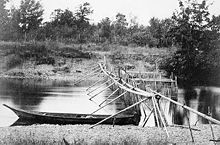Fishing weir
[6] In September 2014 researchers from University of Victoria investigated what may turn out to be a 14,000-year-old fish weir in 120 ft (37 m) of water off the coast of Haida Gwaii, British Columbia.These were described in 1705 in The History and Present State of Virginia, In Four Parts by Robert Beverley Jr: At the falls of the Rivers, where the Water is shallow, and the Current strong, the Indians use another kind of Weir thus made.They make a Dam of loose stone where of there is plenty on hand, quite across the River, leaving One, Two or more Spaces or Tunnels, for the water to pass thro': at the Mouth of which they set a Pot of Reeds, Wove in form of a Cone, whose Base is about Three Foot, and in Perpendicular Ten, into which the Swiftness of the Current carries the Fish, and wedges them in fast, that they cannot possibly return.[8] In the Back Bay area of Boston, Massachusetts, wooden stake remains of the Boylston Street Fishweir have been documented during excavations for subway tunnels and building foundations.[9] A large series of fish weirs, canals and artificial islands was built by an unknown pre-Columbian culture in the Baures region of Bolivia, part of the Llanos de Moxos.They are known as atob in the Visayas Islands of the Philippines, maai in Chuuk, aech in Yap, loko ‘umeiki in Hawaii, and pā in New Zealand, among other names.[15] Most stone fish weirs are believed to also be ancient, but few studies have been conducted into their antiquity as they are difficult to determine due to being continually rebuilt in the same location.[16] The technology of tidal stone fish weirs has also spread to neighboring regions when Taiwan came under the jurisdiction of China and Imperial Japan in recent centuries.[17] In Great Britain the traditional form was one or more rock weirs constructed in tidal races or on a sandy beach, with a small gap that could be blocked by wattle fences when the tide turned to flow out again.






fish trapfish corralManila BayPhilippinesintertidal zonesalmonfish ladderfish trapsmodern humansbarrier netAcheuleanCowichan RiverVancouver IslandAlgonquinJohn WhiteHaida GwaiiPotomac RiverJames RiverRobert Beverley JrMaryland General AssemblyBack BayBoylston Street FishweirNova ScotiaShubenacadieBay of FundyherringBritish ColumbiaHudson Bay LowlandsBaures regionBoliviaLlanos de MoxosChiloé IslandDouble-Heart of Stacked StonesPenghuTaiwanHonokohauHawaiiVanuatuAustronesian peoplesPenghu IslandMicronesiaeastern IndonesiaMelanesiaPolynesiaVisayas IslandsNew ZealandindigenousTaokas peopleMiaoli CountyImperial JapanKyushuRyukyu IslandsSouth KoreaJeju IslandHan Chinesemedieval Europetidal raceswattleTraeth LligwyMenai StraitYnys Gored GochAberarthWorld War IMoelfre, AngleseyAncient MonumentMagna CartaEdward IIIEdward IVHenry VIIIThomas CromwellConquestLisle PapersUmberleigh24 & 25 Vict.IrelandShimabara PeninsulaMartinsville Fish DamMogami RiverDemocratic Republic of the CongoSomersetanchovyOosterscheldeBergen op ZoomDesert kiteFish screenMnjikaning Fish WeirsTailrace fishingWayback MachineFishing tackleFish hookCircle hookHooksetSniggleFishing lineBraidedMonofilamentMultifilamentPower proSwivelFishing sinkerArlesey BombBombardaDownriggerSandsinkerFishing rodBamboo fly rodFishing reelFishing rod tapersFly rod buildingFishing baitBait fishBoiliesGroundbaitVermicompostWorm charmingPlastic baitDeadstickingPlastic wormFishing luresArtificial flyHeddonLittle CleoMormyshkaOriginal FloaterSabikiSpinnerbait

